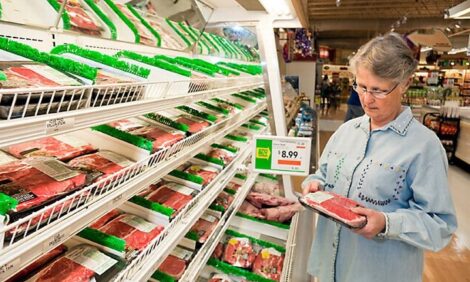



Innovations and Trends at EuroTier 2012
GERMANY - EuroTier represents the largest European and world innovations market for machinery, equipment and farm inputs as well as for management of professional animal husbandry. This year, with 300 innovations submitted by altogether 182 exhibitors from 23 countries, EuroTier has reached an absolute new record.It is noteworthy that around half of the innovations submitted come from exhibitors based outside Germany. Accordingly EuroTier and the products presented there are more international than ever. The large number of very interesting new and further developments and substantial improvements of already known products shows above all that the innovative force of manufacturers in the field of agricultural animal husbandry is by no means decreasing, but instead remains at a strong, high level.
The importance of an innovation for practical work and animal welfare, as well as its impacts on farm and labour management, the environment and the energy situation are crucial for the selection of award-winning products. Any impacts on work facilitation and work safety are also taken into consideration in the decisions on awards. The innovative products winning a Gold or Silver Medal at EuroTier 2012 have not previously been shown and/or selected for an award at any other major exhibition or international show before. Moreover, these products must be fully operable at the time of the exhibition and be available on the market in the year 2013.
The award-winning products in particular therefore represent an ideal guide for all those visitors to EuroTier who are specifically looking for innovations. The EuroTier Innovations Magazine that will be published in German and English at the end of October will facilitate efficient use of the visit to the exhibition. Furthermore, alongside the award-winning innovations, a list of company innovations will include products that are already known on the market, but are new for the company. However, a certain degree of innovation should be visible in these too. The company innovations list will be published on the internet [click here].
The altogether 14 sectors from which the products submitted for awards were suggested include both "more recent" fields, such as for example aquaculture, and "classics", such as for example keeping, feeding, climate control, dung removal, energy and environmental technology, as well as machinery and equipment for milking and refrigeration. In addition a large number of innovations have been submitted in the fields of farm inputs, feed storage and feed production, equipment, accessories and spare parts, management and software, and stable and hall construction. Altogether the Gold and Silver Medals awarded at EuroTier 2012 reflect the bandwidth of the respective sectors and include products for the animal species cattle, pig and poultry. The largest numbers of medals were awarded in the fields of "Machinery and equipment for keeping and feeding - cattle and pigs", "Management and software" and "Farm inputs and machinery and equipment for their use".
Trend towards system solutions
In the past "technical island solution" innovations with a new concept that critically changed their function or developed it further to such an extent that a substantial improvement of the function and method could be expected were frequently submitted and won awards.
At EuroTier 2012, on the other hand, the growing trend towards system solutions cannot be denied. There is now a tendency for products and methods that used to be considered more individually to be purposively and expediently linked together. Depending on the respective operating status and information level of, for example, sensors and products in relation to each other, these system solutions are now able to control/regulate and even optimize entire process chains automatically. This can improve quality assurance of production and products, render them more transparent, and enhance the work quality and performance in agricultural animal husbandry, as well as lowering operating costs. All this naturally also leads to sustainably securing the operating profit of the farm.
Trends in machinery, equipment and management for pigs
This year's very versatile innovative trends in pig husbandry are characterized not least by the fact that technical solutions are being offered for questions arising in particular from more recent framework conditions concerning pig husbandry methods and from improving animal welfare in keeping methods. For instance if boar fattening is to feature more strongly in future, the different feeding demands of sows and boars will become more significant and with this the process-specific solutions satisfying these.
Generally methods for improving herd monitoring, individual animal monitoring and management, as well as for group keeping of sows and of finishing pigs are becoming increasingly important. The aim is to be able to "keep an eye" better on each individual pig.
In the feeding sector great value is still attached to operational reliability and easy use of machinery and equipment. Practicable products that provide occupational material for pigs are still in demand.
Trends in machinery, equipment and management for cattle
This year's EuroTier will also be showing many innovative developments in the field of cattle husbandry. With regard to feeding, innovations are evident both in proper ensiling and unloading of basic feed and in swift determination of the feed value.
A further focal area lies in system solutions that on the one hand substantially improve monitoring of the animal condition and animal health, and on the other hand expediently link and coordinate control, regulating and work processes in the dairy cattle shed, as well as helping to visualize and monitor these. Furthermore, system solutions that allow the greatest possible automation and standardization in data communication between the farm and external partners are also presented.
In the field of mechanical milk withdrawal it is evident that innovations have by no means reached their limits in modern milking machinery and equipment, and that completely or partially automatic milking is consistently continuing to grow. This also applies for the use of information about milk ingredients for health monitoring by means of analytical equipment based on the farm.
In the field of calf rearing, innovations that monitor birth as automatically as possible are becoming increasingly significant.
Trends in machinery, equipment and management for poultry
In the area of poultry farming innovations are being presented in a wide variety of fields. These start with objective inspection and optimal setting of husbandry parameters in line with animal welfare and measures to reduce the use of medicines (antibiotics) and end with optimizing dung removal systems such as are used in modern keeping systems (e.g. small groups, aviary). In addition, new processes in poultry processing are presented that increase product safety and considerably reduce the use of natural resources, thus also contributing to environmental protection.
Trends in management and software
As described already for the various animal species, trends in management and software are moving towards comprehensive system solutions. These primarily address expedient and automatic linking, processing and use of process-related and operation-relevant data and automatic and standardized import and export of these. Such data are to be made available to users independently of time and place and serve to optimize husbandry and process conditions as well as energy consumption, use and provision of energy, product safeguarding, quality enhancing and labour facilitation.
Trends in farm inputs and machinery and equipment for their use
In the field of farm inputs and machinery and equipment for their use it is evident that innovative solutions for promoting feeding as far as possible in line with animal welfare, improving feed conversion, using probiotic effects and reducing the use of medicaments are more in demand than ever. After all, these not only lead to improved animal health but also allow us to expect distinct effects relieving the burden on the environment. Innovations that have positive effects on working time, material consumption and material recycling will also be shown in the field of optimal production of silages in mobile silos.








